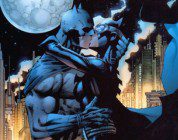People tend to forget the name. Often, it works to simply say he was just a random guy with a gun, looking to score some cash when he shot a young boy’s parents. It’s easy to associate him with the symbol of crime and how the only real deterrent against it is vigilance. But he had a name: Joe Chill. And he was the man who indirectly created Batman.
When he first appeared in a flashback, his name wasn’t as important as the role he played in Bruce Wayne’s life. Then he actually appeared when Batman was an established force against crime in Gotham. And regardless of the continuity, every time Chill enters Batman’s life, it’s always something to see.
The First Time
Chill made his first named appearance in 1948, when Batman was investigating the small-time crime boss and realized that he was the one who kill his parents. However, every attempt to nail the man fails. Left with little choice, Bruce revealed that he was Batman, that he knows what Chill did, and would spend the rest of both their lives tormenting him until he could finally capture him. In a panic, Chill ran to his men, telling him that he killed Batman’s parents. In a rage, his own henchmen gunned him down for creating Batman before he could reveal the secret. After taking out the goons, Batman watches Chill die in his arms, and the crime boss comments on how his men killing him for setting Bruce on his path was essentially Batman avenging the Waynes in a way.
This was one of the best of the Golden Age Batman stories. It’s often been theorized that finally getting closure on his parents’ deaths is what led to Batman become the more friendlier version of the Silver Age. In time, it was revealed that Chill was actually hired to kill Thomas Wayne by Mafia boss Lew Moxon. Moxon had been beaten and captured by Thomas Wayne during a costume party (Wayne dressed, interestingly enough, as a bat). While not as strong as the original Chill story, both aspects were combined beautifully in the Batman: The Brave and the Bold episode “Chill of the Night.”
The Retelling
In 1987, a storyline called Batman: Year Two came out. In it, Batman is now an established crimefighter, and things seem to be going well. Then the Reaper, Gotham’s first vigilante returns. The skull-masked, scythe-and-gun wielding madman doesn’t share the love of life that Batman has, and when he loses, Bruce decides his only way to stop further death is to form an alliance with Gotham’s mobs. Armed with the gun that killed his parents, Batman agrees to work with a hired killer to take down the Reaper. That man? Joe Chill.
This was an awesome story, especially because Chill reveals that his early days he was simply a mugger, but rose in rank to become one of the best. His alliance with Batman was interesting to watch, since our hero wants to kill him, and Chill is supposed to kill Batman after the Reaper is dealt with. In the end, which I won’t spoil, resolution is had all around. It was also the last really good story with Joe Chill in comics.
Chill’s legacy has often been diminished, with the ’89 Tim Burton film making the Joker the killer of the Waynes (not a good idea, since it makes Batman more about revenge than justice). In the 90’s event Zero Hour, Chill was retconned out of being the killer, leaving the case still unsolved. After the event of Infinity Crisis, Chill was restored to continuity, but was now captured the same night he killed the Waynes, like in Batman Begins. Grant Morrison even brought Chill back for a strange story where Batman torments him into committing suicide. However, given how much of Morrison’s run dealt with Bruce having hallucinations, it’s doubtful if this is now cannon.
I’d be remiss if I didn’t address what I think is the best depiction of Chill outside of Year Two: his appearance in the Nolan film Batman Begins. That version of Chill was just a scared guy, driven to crime by the poverty that Gotham was having at the time. When he makes a plea bargain for parole in exchange for testifying against mob boss Carmine Falcone, he says that he feels regret for what he did. Bruce plans to kill him, but doesn’t get his chance because Falcone has him assassinated. Leaving this ambiguous take on Chill helps sell the point that Batman isn’t about vengeance as it is about justice and hope. Making Chill less evil and more just a symptom on how one could easily turn to crime helps push the nature of the films, how fear can be used to ruin society and hope can help fix it.
Joe Chill has always been a big part of Batman’s existence, and I’m sure as time goes on he’ll continue to be relevant. Here’s hoping the New 52 doesn’t ruin it.



